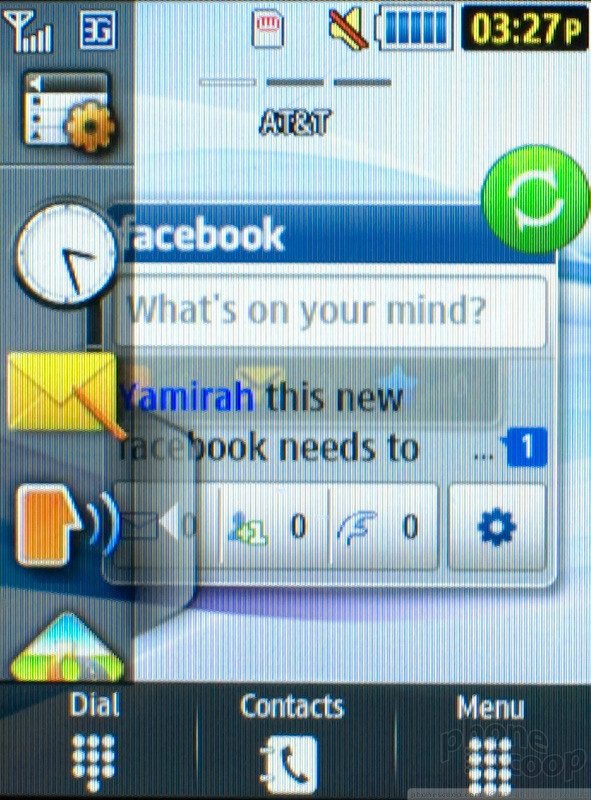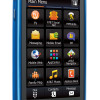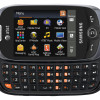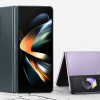Review: Samsung Flight II
The Samsung Flight II uses Samsung's TouchWIZ interface design. TouchWIZ gives the user three homescreen panels, and you can move from one to the other by swiping left and right. There is a drawer filled with widgets on the left side of the screen, and you drag these out onto the panels to use them. The problem begins with the touch issues I found on the Flight II. The phone is not very responsive to swiping or dragging, and TouchWIZ relies on these actions. So, it's difficult to arrange the homescreens the way you like. Widgets are difficult to understand because they are not labeled. So you might not be sure what you're getting until you drag them out. Two different widgets are simple silhouettes of three people in a group, but one of them opens up the iSkoot Social Net app, and the other creates a massive, dominating ferris wheel of contact shortcuts on your screen.
This highlights another problem with TouchWIZ. Widgets often overlap, making it difficult to access the features you want. Sometimes I would try drag a widget out of the way to access the one beneath, but the phone would register my dragging motion improperly, thinking I was tapping. Then, the browser would open, or the phone would start a call, or perform some random action from the widget I was trying to move, instead of letting me get to the task at hand.
I can't express my negative feelings about TouchWIZ strongly enough. It does not perform well, it does not help the feature phone experience, and Samsung should have abandoned it long ago. It is telling that the newer version of TouchWIZ on Samsung's high-end Android phones completely removes the drawer and widgets and simply skins Android with a slightly different look.
At the bottom of the homescreen you'll find shortcuts for the Dialpad, the Contacts list and the main Menu. The menu is another set of three panels that you can swipe through. Again, the swiping action causes problems, and the phone often registered a tap when I was trying to swipe, which resulted in another app opening. This was very annoying and caused considerable delay, because the Samsung Flight II is a very sluggish phone. Apps take a long time to open and a long time to close. For all its sluggishness, though, it was quick to go idle and lock the screen on me, causing more delays. There is no way to set the screen timeout to avoid this problem.
The main menu can be rearranged, and you can move icons around on the screen or remove them altogether. You can also add more panels to the menu screens, though not to the widget-based homescreens. You also can't move apps to the home screen; you always have to dive into the menu to find them.
The organization and variety of apps can be confusing, especially if you're not familiar with app branding (and why should a buyer need to be familiar?). For instance, will the average user understand the difference between Mobile Video, MobiTV, and the plain old Video apps? I don't think so. Even worse, there is an AppCenter, where you can purchase new apps for download from AT&T's anemic selection, or the Application folder, where your apps are stored. I could easily imagine new users confusing the two and stumbling into unnecessary downloads.
The Flight II does have a basic form of fast application switching. Some apps will give you the option of quitting or suspending them, leaving them open in the background. You can then press the app switch key on the side and a menu will pop up. This is a faster way to jump back into the music player, or the Web browser, for instance. If the phone gets bogged down, that pop up menu also lets you kill all the apps that are currently running.
The Samsung Flight II was ridiculously buggy. Widgets would disappear, then reappear for no apparent reason. Tapping on text fields might have no effect some times. Apps often crashed, sending me back to the homescreen, or simply froze until I hit the End key.







 Samsung Makes Eternity II and Flight II Official for AT&T
Samsung Makes Eternity II and Flight II Official for AT&T
 Samsung Flight II SGH-A927 Headed to AT&T
Samsung Flight II SGH-A927 Headed to AT&T
 Samsung Refines its Foldable Phones
Samsung Refines its Foldable Phones
 iPhone 14 Plus Offers a Big Screen For Less
iPhone 14 Plus Offers a Big Screen For Less
 Hands On with the Motorola razr and razr+ (2024)
Hands On with the Motorola razr and razr+ (2024)
 Samsung Flight II
Samsung Flight II



